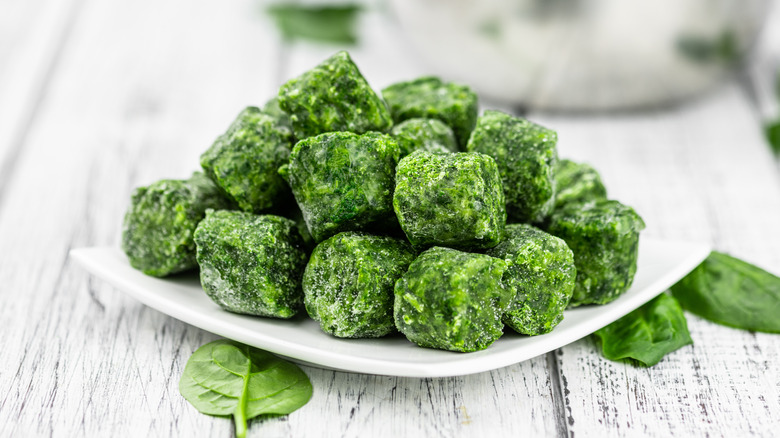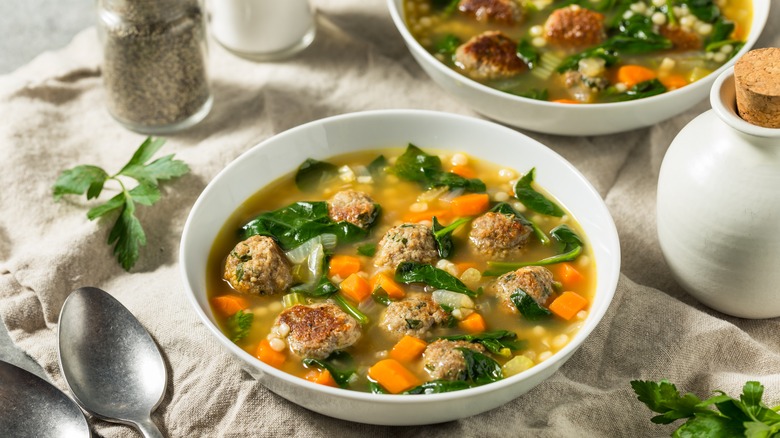Ina Garten's Secret To Creamed Spinach Is In The Freezer Aisle
Creamed spinach is a way of serving the leafy green vegetable that can tempt even those who wouldn't normally touch the stuff if it were simply sauteed. The creaminess and buttery richness makes it a classic side that pairs perfectly with everything from steak or chicken to fish dishes. Ina Garten is also a fan, and her version is super simple thanks to one key staple ingredient: frozen spinach.
Choosing frozen spinach rather than fresh has a number of advantages when cooking. It's more affordable, takes up far less space to store since it's already cooked, lasts longer, and you can just use the amount you need, so it often means less waste. And it's so simple to incorporate in dishes such as curries, casseroles, soups, or the Barefoot Contessa's creamed spinach gratin.
Garten is a big fan of the frozen ingredient, which she describes as "just as good as fresh and so much easier" (via YouTube). It just takes a few key steps when preparing the vegetable to ensure the best possible results in the finished dish.
Ina Garten uses frozen spinach for her gratin
Ina Garten preps the spinach for her creamy gratin by first defrosting the frozen vegetable. The easiest way to do this is to thaw the amount you need in a bowl in the refrigerator overnight, but if you're in a hurry, you can run it under cold water for a faster result.
Then you'll need to squeeze the life out of the spinach, which is a vital step before you add it to the other ingredients. Removing this excess water stops the spinach leaves from becoming overly mushy and ruining the consistency of the gratin. Garten just uses her hands to squeeze the liquid from the thawed spinach, but there are a couple of other methods, too. Try wrapping it in a paper towel or tea towel before squeezing to absorb more moisture, or you could even use a salad spinner or large potato ricer.
A combination of parmesan and Gruyère cheeses adds extra savory flavors to the Barefoot Contessa's gratin, along with a little aromatic nutmeg, which helps to add depth and make the flavor really pop. But there are many other ingredients that can also boost spinach if you want to experiment with different flavor combinations. A touch of cayenne or red pepper flakes is an easy way to add some extra heat — or try adding fragrant fresh-picked herbs such as basil, dill, and tarragon.
More tips for cooking with frozen spinach
Frozen spinach is incredibly versatile, and you can use it as a substitute for fresh in pretty much any dish that features blanched spinach since it has already been blanched before being frozen. It makes a great addition to dips, is a tasty way to top a pizza or tart, and makes delicious savory breakfast muffins. It works just as well in omelets or stuffed into chicken breasts with creamy mozzarella before being baked.
When adding frozen spinach to dishes that require baking, such as Ina Garten's creamed spinach gratin or a spinach and ricotta lasagna, the leafy green should be thawed and drained first. But in some other more liquid-based dishes, such as soups, curries, or pasta sauces, the spinach can be added straight from the freezer, making it a convenient boost for quick and easy meals.
When it comes to the amount of spinach to use when frozen versus fresh, it's worth remembering that they do not yield exactly the same final volume. A pound of fresh spinach will give you around a cup's worth once it's been cooked — whereas a single 10-ounce pack of frozen spinach will cook down to more like 1½ cups. Essentially, you'd need one package of frozen leaves for each 1 ½ pounds of fresh that a recipe specifies. So just be sure to adjust the quantity accordingly, depending on the dish in question.



